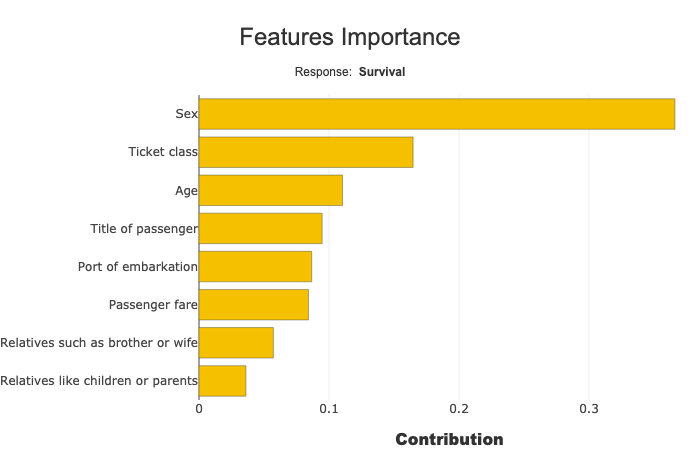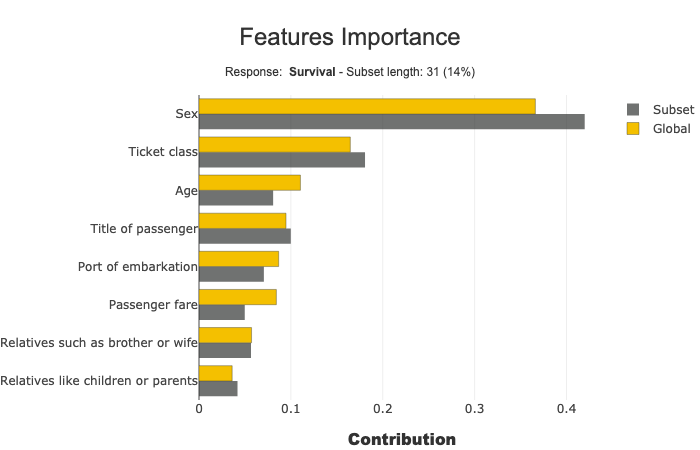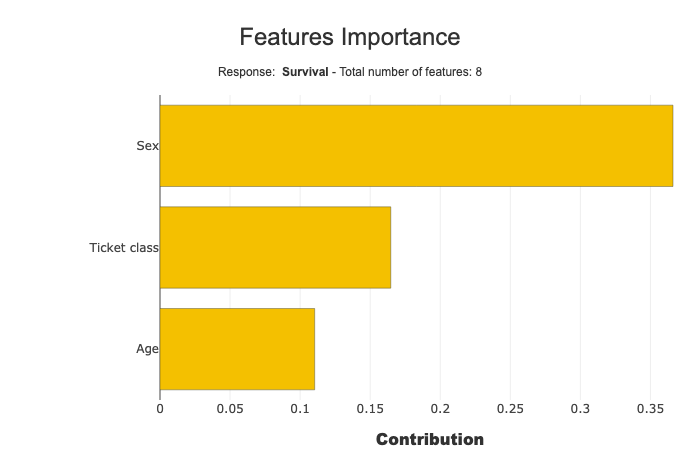Features importance¶
The methode features_importance displays a bar chart representing the sum of absolute contribution values of each feature.
This method also makes it possible to represent this sum calculated on a subset and to compare it with the total population
This short tutorial presents the different parameters you can use.
Content : - Classification case: Specify the target modality to display. - selection parameter to display a subset - max_features parameter limits the number of features
We used Kaggle’s Titanic dataset
[1]:
import pandas as pd
from category_encoders import OrdinalEncoder
from sklearn.ensemble import ExtraTreesClassifier
from sklearn.model_selection import train_test_split
Building Supervized Model¶
Load Titanic data
[2]:
from shapash.data.data_loader import data_loading
titanic_df, titanic_dict = data_loading('titanic')
del titanic_df['Name']
y_df=titanic_df['Survived'].to_frame()
X_df=titanic_df[titanic_df.columns.difference(['Survived'])]
[3]:
titanic_df.head()
[3]:
| Survived | Pclass | Sex | Age | SibSp | Parch | Fare | Embarked | Title | |
|---|---|---|---|---|---|---|---|---|---|
| PassengerId | |||||||||
| 1 | 0 | Third class | male | 22.0 | 1 | 0 | 7.25 | Southampton | Mr |
| 2 | 1 | First class | female | 38.0 | 1 | 0 | 71.28 | Cherbourg | Mrs |
| 3 | 1 | Third class | female | 26.0 | 0 | 0 | 7.92 | Southampton | Miss |
| 4 | 1 | First class | female | 35.0 | 1 | 0 | 53.10 | Southampton | Mrs |
| 5 | 0 | Third class | male | 35.0 | 0 | 0 | 8.05 | Southampton | Mr |
Load Titanic data
[4]:
from category_encoders import OrdinalEncoder
categorical_features = [col for col in X_df.columns if X_df[col].dtype == 'object']
encoder = OrdinalEncoder(
cols=categorical_features,
handle_unknown='ignore',
return_df=True).fit(X_df)
X_df=encoder.transform(X_df)
Train / Test Split + model fitting
[5]:
Xtrain, Xtest, ytrain, ytest = train_test_split(X_df, y_df, train_size=0.75, random_state=7)
[6]:
clf = ExtraTreesClassifier(n_estimators=200).fit(Xtrain,ytrain)
First step: You need to Declare and Compile SmartExplainer¶
[7]:
from shapash import SmartExplainer
[8]:
response_dict = {0: 'Death', 1:' Survival'}
[9]:
xpl = SmartExplainer(
model=clf,
preprocessing=encoder, # Optional: compile step can use inverse_transform method
features_dict=titanic_dict, # Optional parameters
label_dict=response_dict # Optional parameters, dicts specify labels
)
[10]:
xpl.compile(x=Xtest)
Backend: Shap TreeExplainer
Display Feature Importance¶
[11]:
xpl.plot.features_importance()

Multiclass: Select the target modality¶
Features importances sum and display the absolute contribution for one target modality. you can change this modality, selecting with label parameter:
xpl.plot.features_importance(label=‘Death’)
with label parameter you can specify target value, label or number
Focus and compare a subset¶
selection parameter specify the subset:
[12]:
sel = [581, 610, 524, 636, 298, 420, 568, 817, 363, 557,
486, 252, 390, 505, 16, 290, 611, 148, 438, 23, 810,
875, 206, 836, 143, 843, 436, 701, 681, 67, 10]
[13]:
xpl.plot.features_importance(selection=sel)

Tune the number of features to display¶
Use max_features parameter (default value: 20)
[15]:
xpl.plot.features_importance(max_features=3)

